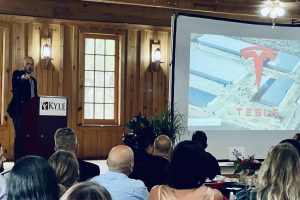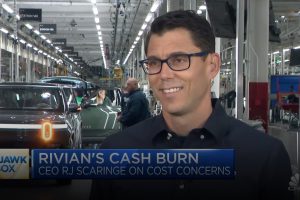- 🌍 Panasonic Energy is developing a new battery plant in De Soto, Kansas, using lessons from Tesla Giga Nevada.
- 🏭 The Kansas facility aims to be the largest battery manufacturing plant in the world.
- 🚗 Panasonic and Tesla have been partners in battery cell production since 2017 at Giga Nevada.
- 🔋 The Kansas facility will produce 2170 cells.
- 💰 Panasonic is investing $4 billion in the Kansas battery plant.
- 🏗️ The facility, at 4.7 million square feet, is less than 50% complete as of late June.
- 🛠️ The plant will feature two wings, each with four battery assembly lines.
- 🚧 Construction on wing one is finished externally, and equipment installation has begun.
- 🎯 The target for the Kansas facility to begin operations is spring 2025.
- 💼 Panasonic plans to hire over 4,000 employees for the new facility, with starting pay between $20 and $30 per hour.
As the global demand for electric vehicles (EVs) continues to surge, the need for efficient and scalable battery production has never been more critical. Panasonic Energy, leveraging its extensive experience and partnership with Tesla, is taking significant steps to address this demand. By applying the lessons learned from their operation at Tesla Giga Nevada, Panasonic is poised to revolutionize battery manufacturing with their new facility in De Soto, Kansas.
The Ambitious Vision: Largest Battery Manufacturing Plant
Panasonic Energy has set a lofty goal for its upcoming facility in Kansas: to become the largest battery manufacturing plant in the world. This ambition reflects the company’s commitment to scaling up production capabilities and supporting the rapid growth of the EV market. The notion of achieving such a milestone also speaks to Panasonic’s confidence in leveraging its experience from Giga Nevada.
A Proven Partnership: Panasonic and Tesla
Since 2017, Panasonic and Tesla have collaborated closely on battery cell production at Giga Nevada, often referred to as Gigafactory 1. This partnership has been instrumental in propelling both companies to the forefront of the EV industry. By bringing the technological advancements and operational expertise gained from Nevada to Kansas, Panasonic is well-equipped to tackle the challenges of mass battery production.
Cutting-Edge Production: Focus on 2170 Cells
One of the standout features of the new Kansas facility is its focus on producing 2170 cells, a critical component used in Tesla’s vehicle lineup. These cells are renowned for their energy density and efficiency, making them a popular choice in the EV industry. The shift to 2170 cells signifies Panasonic’s dedication to producing high-performance batteries that meet the evolving needs of modern electric vehicles.
Investment and Infrastructure
Panasonic is making a substantial investment of $4 billion into the Kansas battery plant, underlining their long-term commitment to the EV sector. The scale of the facility is equally impressive, covering 4.7 million square feet. As of late June, the plant is less than 50% complete, but significant progress has been made. The external infrastructure for wing one is finished, and equipment installation is already underway.
Structuring for Success: Two Wings, Eight Assembly Lines
The Kansas facility is designed with efficiency and scalability in mind. It will feature two primary wings, each housing four battery assembly lines. This layout ensures streamlined production processes and the capability to ramp up capacity as demand increases. With construction on wing one nearly complete, attention is now turning to wing two, which will continue to evolve in tandem with the equipment installations in wing one.
Timeline to Operations: Spring 2025
Despite the ambitious scale of the project, Panasonic Energy is on track to commence operations at the Kansas facility by spring 2025. This timeline reflects the urgency and dedication of Panasonic to start contributing to the EV supply chain as swiftly as possible. The countdown to 2025 also aligns with the broader market expectations for increased EV adoption in the coming years.
Job Creation and Economic Impact
A project of this magnitude brings with it significant economic benefits, particularly in job creation. Panasonic plans to hire over 4,000 employees for the Kansas facility, offering starting pay between $20 and $30 per hour. These jobs will not only provide economic stability to the region but also contribute to the growth of a skilled workforce in advanced manufacturing and technology sectors.
The Road Ahead: Challenges and Opportunities
While the vision for the Kansas battery plant is clear, the road ahead is not without challenges. The rapid pace of technological change in the EV industry demands continuous innovation. Moreover, the supply chain for raw materials like lithium and cobalt remains volatile. However, Panasonic’s strategic partnership with Tesla and their significant investment in infrastructure position them well to navigate these hurdles.
Conclusion
In conclusion, Panasonic Energy’s new battery plant in De Soto, Kansas, represents a bold and forward-thinking step in the evolution of battery manufacturing. By applying the lessons learned from Tesla Giga Nevada, Panasonic is set to create a facility that not only meets the growing demands of the EV market but also sets new standards in efficiency and scale. With substantial investment, cutting-edge technology, and a strong focus on job creation, the Kansas facility is poised to become a cornerstone of the global EV supply chain.





